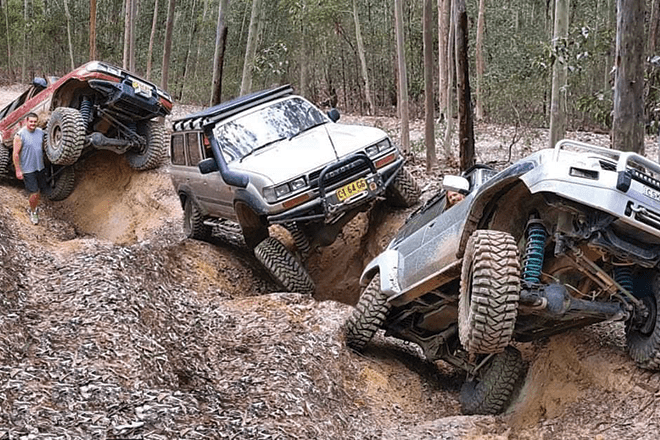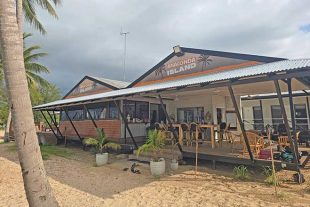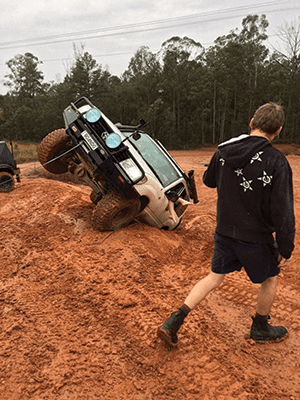
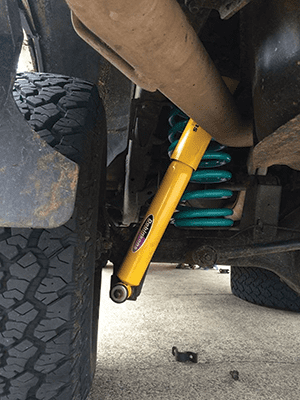
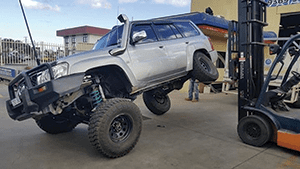
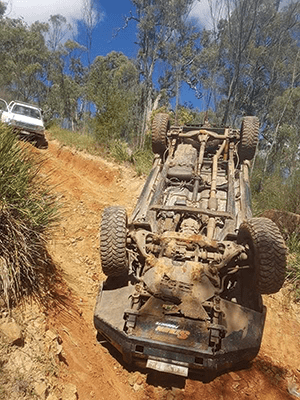
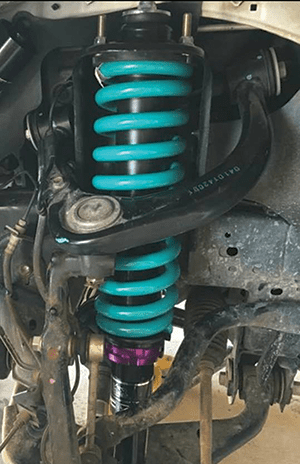
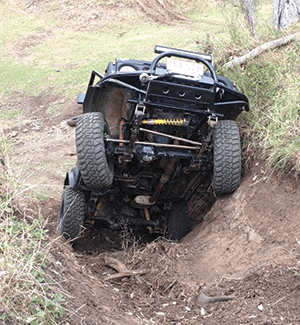
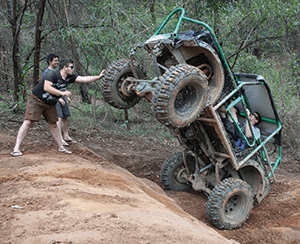
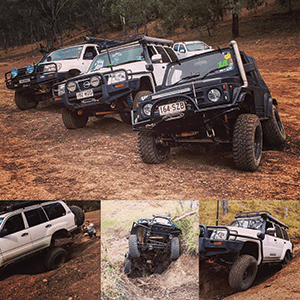
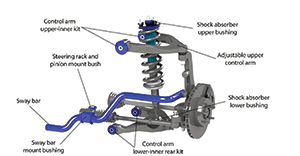
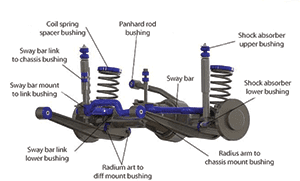
THOSE who have been around the four-wheel-drive community for any extended period would have likely entered into or seen some kind of debate around independent front suspension versus solid axle.
For those who have only just stepped into the community, trust me, you’re bound to experience it too. But what are IFS and solid axles and why is this an ongoing subject of debate? Well let’s kick off this article explaining what IFS, IRS and solid axles are before jumping into what the differences actually mean for you and your rig. IFS consists of three main sections – a differential and a control arm with hub assembly on either side.
Having three sections allows the suspension to move independently on either side. Independent suspension utilises constant-velocity joints without a housing protecting the joint.
IRS is exactly the same concept except on the rear of the vehicle. IRS and IFS generally run one of four types of springs: coils, coilovers, torsion bars or airbags. Solid axles are exactly that, a solid axle housing that spans the width of the vehicle and houses the differential and CVs/axles within.
Solid axles run one of four types of springs: coils, coilovers, leaf springs or airbags. Now, why do people spend their time debating on IFS or solid axle? Well, it’s actually pretty simple, a large portion of the 4WD community wants to be able to say that their choice of 4WD is better or more capable than others. But in reality it is like the saying, “Horses for courses”.
Each individual should buy a rig that meets their needs and desires.
For some, that is independent suspension, for others (me), solid axles are more appropriate and the reason for this is the same reason why a drift car’s suspension setup is different to a V8 Supercar or seven-second drag car. Each suspension setup has pros and cons and each setup stands out in its specific field. Now before knowing anything about different styles of suspension when buying a new 4WD, you really need to sit down and assess your needs and desires and consider the reality and balance between what you want to do versus what you’ll actually do.
Those who are buying a rig to drive in the city for 95 percent of the time and hit the odd dirt track or beach trip really need to buy a different style of fourby than those who are planning on going rock hopping and tackling extreme tracks on a regular basis. For me, when I started 4WDing I had absolutely no idea what I would end up doing and fully expected to drive on some easy dirt roads and go camping in random places.
But after my first experience tackling challenging tracks I was led in a completely different direction and I was forced to adapt, well, modify I should say! As mentioned, each style of suspension has a range of pros and cons. My favourite benefit of IFS is the ability to easily lift wheels while driving challenging tracks and readily create mental photo opportunities.
This is an acquired taste and I can confirm I have made quite a few passengers freak out when I’ve lifted a wheel over 1m off the ground before jumping out to take a photo!
On a more serious note, the main purpose of IFS is comfort and stability. Due to each wheel moving independently, the body of the vehicle has less movement, allowing the car’s stability to increase and disruption from each bump is transferred on one corner rather than the entire front end. The increase in stability and comfort is why most passenger vehicles and race cars (both on and off-road) run independent suspension.
Other IFS benefits include ground clearance while off-road, due to the nature of IFS manufacturers being able to lift the differential housing higher, which in turn gives better ground clearance from factory. However, this has a detrimental effect for those who wish to modify their vehicles. The issue is that because of the way IFS works – with a differential in the middle and control arms and hubs moving independently – the CVs are on an angle from standard.
Once the vehicle is lifted, the differential lifts up, as do the inside of the control arms, however the outsides remain at the same height because they are mounted to the hub and wheel.
As the chassis and body move upwards, the CV angles become sharper and this often leads to premature wear and breakage of CVs. Unfortunately, lifting an IFS vehicle is costly and the height of suspension lift is generally limited to about 3”.
With so many moving parts in the suspension setup, IFS vehicles also often suffer from undersized steering components. Of course, these steering components are adequate for standard road driving, however once modified with larger wheels, suspension lifts and enduring off-road use, standard components are often pushed to or past their capacity. An example of this is tie rods, which are a steering component that often consists of two joints and a rod in the middle.
With IFS one is on either side and the rods are often constructed from 10mm-thick steel, which commonly bends when steering against a hard surface such as a rock. Solid axle vehicles have just as many positives and negatives, and again, the saying horses for courses is well and truly applicable! Solid axle vehicles generally have much larger components, which bring the downfall of extra weight, however the benefit is greater carrying capacity, stronger gear and flex.
Flex and stronger components are the two main benefits that sway my decision when thinking about the best suspension setups. For me, previously owning IFS vehicles and now owning solid axle vehicles, I am often relying on the strength of the solid axles to push through challenging tracks without acquiring damage or mechanical issues. Solid axle vehicles run the CV joints within the axle housings, which negates the need for a rubber boot around the joint itself and reduces the requirement for two joints per side down to one per side – this means longer-lasting CV joints.
The downside is a CV breakage on a solid axle vehicle often takes much longer to repair. Unfortunately, due to a large metal casing solid axles weigh a lot, which takes its toll on your fuel economy, however also poses benefits off-road. The axle will often move upwards on one side, tucking into the wheel arches. As this occurs the body leans towards that side while the opposite side of the axle pushes away from the body and naturally provides a form of counter weight.
This has benefits for driving deep rutted tracks and due to the design of solid axle suspension there is a large degree available for articulation (flex!), which improves comfort while driving deep rutted tracks. Long story short, it’s harder to lift wheels on a solid axle vehicle than it is on an IFS or IRS vehicle. Solid axles come with other downsides such as less ground clearance due to the pumpkin (differential housing), costly parts and the challenges around correctly adjusting camber.
At the end of the day, I don’t believe in a better suspension type, however a solid axle vehicle simply makes more sense for me! In saying that, when I eventually move into wider touring, family making and sensible life choices I will likely move back to independent suspension. For now, I will continue enjoying the flex I have with my car and constantly missing the feeling of lifting wheels over 1m into the air and freaking out my passengers.
Now, don’t forget Flexible 4WD Solutions has access to a wide range of suspension components to suit your needs and we are just a call away! We’d also like to extend the offer of a simple chat to any readers who either want advice on choosing a suspension type for their lifestyle or would like more information on this month’s article (or to debate with us!).
Peace out and we hope you have a merry Christmas and happy New Year.
 Bush 'n Beach Fishing Magazine Location reports & tips for fishing, boating, camping, kayaking, 4WDing in Queensland and Northern NSW
Bush 'n Beach Fishing Magazine Location reports & tips for fishing, boating, camping, kayaking, 4WDing in Queensland and Northern NSW

